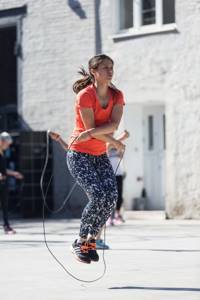Workouts that will effectively influence the process of losing excess weight contain cardio.
There are a lot of options: running, climbing stairs, walking, various exercise machines.
Many people prefer a jump rope.
This choice is due to the high performance of this equipment, its availability and a number of other positive factors.
The mechanism of action of jumping on the muscles and tissues of the body

Any long jumps will be considered aerobic exercise. The exercise requires some technique, but you can learn it on your own, without the help of a trainer. How to jump correctly is understood intuitively, based on your own feelings.
The mechanism of action on the muscles of the body does not differ from ordinary high jumps, but each time the jump rope forces you to make the next movement at a strictly designated moment.
When working, the leg muscles are involved, the joints and ligaments are significantly loaded, which indicates that a warm-up is mandatory, after which you can move on to low-intensity movements and only gradually speed up the pace.
Interesting! Jumping rope exercises will not build muscle mass, since the exercise is multi-repetitive, aerobic. But the muscles will definitely be toned, and the percentage of body fat will also decrease (subject to diet).
The benefits of exercise for removing fat from the abdomen and sides

Losing weight in the abdomen and sides is the initial goal for many who begin training. Many people begin to pump up their abs, do all kinds of bending, but this does not bring the desired result, since local fat burning is impossible.
Fat can be lost from the entire body as a whole. At the same time, there are areas that lose weight the slowest, which is due to the characteristics of a particular person’s body. Exercises for the abdomen only pump up the muscles, but a layer of fat remains.
A more effective approach is to include cardio in the training process. A jump rope is perfect because it allows you to burn a fairly large number of calories - according to some estimates, up to 900 per hour, but it all depends on the intensity.
The benefits for the abdomen and sides when jumping rope are enormous. Intense training will allow you to spend a significant amount of calories, and accordingly, the fat burning process will start. In addition, jumping rope accelerates metabolic processes for a certain time after exercise, which also has a positive effect on the effectiveness of weight loss.
You may also be interested in: How to remove belly fat for a man at home
Are they suitable for everyone?

Before you start jumping rope correctly, you need to check whether the exercise has any contraindications.
The following points are worth considering:
- During any training with a skipping rope, a significant load falls on the joints of the legs, knees, and ligaments. If there are problems in this area, it is better to replace the exercise or perform it at a slow pace. The presence of pain is a signal from the body about a possible problem.
- If you have problems with the spine, then it is also better to find an alternative.
- When jumping rope, the heart is significantly loaded and blood pressure increases. This is worth taking into account, and if there are contraindications, choose low-intensity training and increase the pace gradually.
In any case, the jumping program should be gradual, that is, the load is minimal at first, and then increases and is brought to the desired level.
You may also be interested in: Exercises in the pool to lose weight on your stomach and sides
Be sure to check out:
Learning to restore breathing after physical activity: useful exercises Basic exercises for all muscle groups: a strong and strong body at home Jumping on a trampoline: effective for losing weight How to maintain excellent physical shape after 40 years: choosing exercises
How and where to start

The training program, if it includes exclusively jumping rope, is drawn up based on physical capabilities, that is, the level of training. A small amount is performed at first, then it increases.
First of all, you should pay attention to the following points:
- the length of the rope must be chosen correctly, it should not get tangled, but the athlete does not need to jump too high;
- First, a warm-up is performed, then low-intensity jumping begins. Only after this can you move on to more complex training;
- Before you start jumping, you should check for any contraindications. Any discomfort in the muscles, heart or joints will be a signal.
Next, you need to draw up at least a rough training plan according to which the jumps will be performed.
The table is a very convenient way of planning; it will allow you to mark the work done and schedule the planned load for the next workout.
Exercises with a jump rope
If you want to challenge excess weight and use jumping exercises against cellulite, you need to set yourself up for a long period. Yes, a couple of centimeters will be removed from your waist and hips in literally 2-3 weeks of regular training, but for lasting results you will have to sweat 4-5 days a week for several months.

You need to start from the correct starting position. Stand up straight, keeping your back straight. Hand position - elbows almost pressed to the body. Move the rope with your hands, do not jump too high, try to spring on your feet.
It is important to monitor your breathing: it should be even and deep. If breathing becomes intermittent and there is a feeling of lack of air, you need to slow down the pace or take a break from jumping for 30 seconds.
Skipping is interesting because there are no static poses in this program; jumps can be varied, accelerated and complicated. First, let's look at the main types of jumps for beginners.
How to do it correctly: options and techniques

The technique of jumping rope is quite simple:
- the rope is taken by the handles in both hands, placed behind the back, arms spread to the sides, but bent at the elbows;
- the athlete twists the rope through himself so that it goes around his body. Most of the movement is done through the wrists rather than the shoulders;
- at the lowest point, when the projectile touches the ground, you need to jump so that the rope passes under your feet. If it does not catch the legs, it means the athlete is not jumping high enough;
- the movement is repeated the required number of times.
This is a common variation of the movement, but there are many variations of the exercise:
- double, when the rope passes around the body twice in one repetition;
- on one leg;
- with arms crossed;
- on one leg alternately, that is, for each jump the leg changes.
As a fat-burning exercise, you can use not only standard jumps, but also various variations. They help diversify the training process and also additionally train coordination of movements.
You may also be interested in: How to remove fat from the inside of your knees
Alternate landings
Jumping jumps can replace jogging or serve as a warm-up between intense approaches. The point of the exercise is that each push from the surface is performed with one leg. This technique uses additional muscle groups. If you raise your hip high in jumps, in addition to your legs and buttocks, your abs are well worked out. If your level of physical fitness allows, you can jump in turn on each leg 100-200 times.
You can complete your strength training with alternating jumps, but to do this, stick to a calm rhythm of jumps.
Effective training program with jumping (table)
The training table is compiled by each athlete or his coach. Alternatively, beginners can use the following program:
| Day 1 |
|
| Day 2 |
|
| Day 3 |
|
| Day 4 |
|
| Day 5 |
|
| Day 6 |
|
| Day 7 |
|
| Day 8 |
|

To increase the intensity, other types of jumps are added to the program, as well as other types of exercises. The number of jumps can be increased further.
Another option is to calculate not by time, but by the number of repetitions performed. For example, on the first day three sets of 50 repetitions are performed, then the number increases to 100. You can also set the total number of jumps that need to be performed during the workout, for example, first 200, then 250, and so on.
You can take short breaks between sets, but it is not recommended to rest for a long time, since it is undesirable to allow a significant drop in heart rate.
Rules for practicing with a jump rope

Such a simple sports equipment, when used correctly, helps to “sculpt” a beautiful relief of the legs and buttocks. You just need to perform the exercises correctly and take into account a couple of subtleties in the exercises:
- Selection of length. A rope that is too short or long will disrupt the rhythm, get tangled, and can cause injury. The ideal length is selected as follows: step on the middle of the rope, grab the ends, press your elbows to your sides and spread your forearms to the sides. At the moment when the position of the arms is perpendicular to the body, the maximum tension of the rope should be felt.
- For training, choose comfortable shoes; the soles should absorb jumps. To avoid discomfort when jumping, it is advisable to wear a sports bra.
- Despite the apparent simplicity of the exercise, do not push the jumps too hard. Give your muscles time to adapt to the load, start with small intervals and a smooth pace. The amplitude and duration of classes increases gradually. The first workouts are jumping for 5-10 minutes at a slow or medium pace with 30-second rest intervals.
- After completing the jumps, be sure to stretch to relieve excess tension from the muscles and consolidate the results.
- The best schedule for skipping is 2-3 days of training, then a day of rest. For the effect of jumping on cellulite and fat deposits to be noticeable, you need to exercise 3-5 times a week.
To combat the manifestations of cellulite more effectively, you should use a special cosmetic product before the main workout.
Increased blood flow and accelerated metabolism in tissues contribute to the deep penetration of active components into problem areas.
How do athletes use it?
The equipment is used in their training programs not only by amateurs working out at home, but also by professionals. It's not just about fitness. Boxers, runners, athletes and many others prefer jumping rope to lose weight, strengthen the heart, leg muscles and work on coordination.
Bob Harper, coach
He has trained many Hollywood stars and knows very well which cardio to choose. Harper doesn't make much of a jump rope, but he is a proponent of interval training, meaning the load should vary from light to heavy throughout the workout. A jump rope will provide such intervals.
Manny Pacquiao, boxer
This famous Filipino boxer regularly uses a jump rope in his training program, along with other types of cardio. He claims that jumping rope helps not only to stay fit, but also to work on coordination and endurance.
Jillian Michaels, trainer
A world-famous fitness trainer and author of many techniques, he actively uses a jump rope in his training programs. She claims that jumping rope is the most effective cardio exercise, as it helps not only in the fight against kilograms and centimeters, but also has a positive effect on the muscles of the lower body and the cardiovascular system.
Contraindications
There are a number of contraindications under which jumping will not work:
- hypertension;
- phlebeurysm;
- cardiovascular diseases;
- problems with joints and spine.
Those who suffer from frequent migraines should perform the exercises with extreme caution. Girls during menstruation, as well as during pregnancy and after childbirth, should also look for a more gentle type of sports activity.
If you perform jump rope exercises correctly, adhering to your training schedule, the results will not take long to arrive. It is important not to forget to monitor your diet, which will help consolidate the achieved results. Jumping rope is a simple and affordable way to change your body for the better in a short time!
Main conclusions
Cardio exercise is most often used to lose weight. Undoubtedly, it is best to combine it with strength training, but weight loss is possible even with one exercise. A great option is jumping rope. You need to increase the load gradually. You can start with a few minutes, then, as it becomes easier, the duration of the session increases.
Before starting training, you need to make sure that there are no serious problems with the heart, as well as the spine and joints. The progression of the load should be smooth; later you can add other types of jumps, as well as other cardio and strength exercises. This will only increase the impact of your studies.











